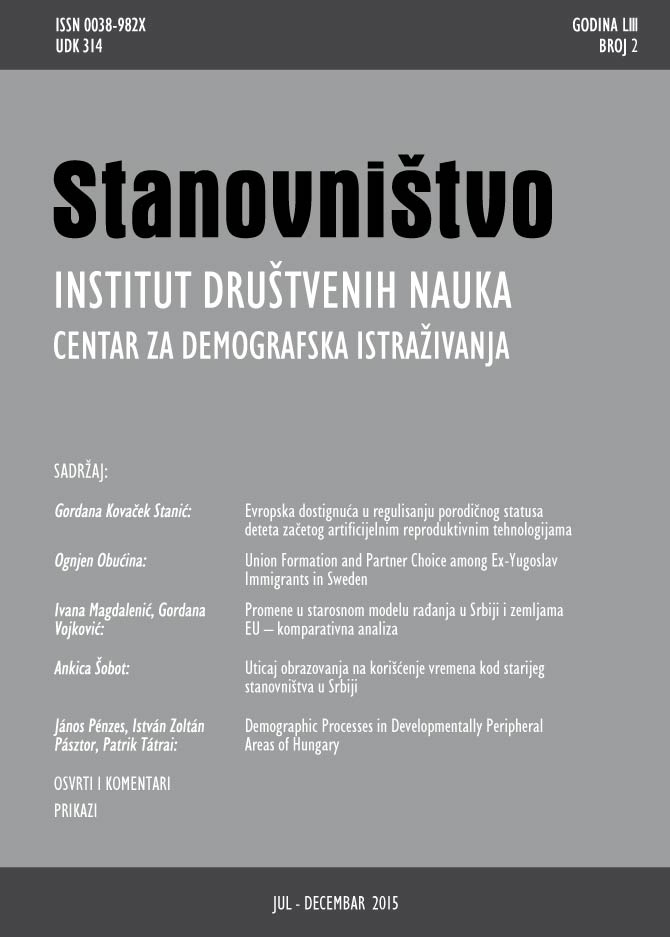Uticaj obrazovanja na korišćenje vremena kod starijeg stanovništva u Srbiji
The Impact of Education on Time Use of Elderly Population in Serbia
Author(s): Ankica S. ŠobotSubject(s): Social Sciences, Sociology, Educational Psychology, Gerontology, Sociology of Education
Published by: Институт друштвених наука
Keywords: the elderly; education; gender; time use; leisure
Summary/Abstract: The active ageing concept, which implies individual and broader social benefits, is defined for mitigating the negative effects of intensive population ageing. It redefines the perception of ageing in accordance with the positive trends in terms of health and life span of older persons' life. One of the factors which has certain impact on some aspects of active ageing is education. The researches confirm its influence on the health and vitality of the elderly, as well as on their economic activity. It is important not only as a dimension of socio-economic status, but also from the perspective of certain behavior, the availability of learning, the possibility of adopting valid information and the use of new technological achievements for the purpose of healthy lifestyle. The top ten countries in 2015 regarding Active Ageing Index have up to four times higher shares of highly educated persons among those aged 50 or over (between 23% and 34%), compared to the countries which are at the back of the AAI list. However, Italy is ranked second, regarding the participation in society despite the fact that less than 10% of persons aged 50 or over are highly educated. By contrast, Estonia has only high index in employment, while in relation to the other spheres is very low ranking, regardless there are 34% of highly educated among persons aged 50 or over. The first example shows that it is possible to achieve partial progress despite low prevalence of high education. Another indicates that the attainment in active ageing can be limited by other factors despite high proportion of highly educated. It is possible to conclude that in either of these two cases high education did not impact, but that these characteristics of active ageing are the consequences of other factors. Participation in society, in addition to volunteering and political engagement, implies caring for children or the elderly. It is possible that the incidence of these activities have more important influence on the positioning of Italy in this sphere. Relatively high index of employment could be explained by the influence of socio-economic conditions and the necessity of working engagement of older persons due to social security and living standards of households. This could be said for Estonia because it is placed into the group of countries with lower GDP per capita. The research regarding the time use in Serbia, used in this paper as the framework for studying the lifestyle of older people, shows that the paid work is the most evident differentiation between those who have entered the older age (65 or older) and those who are on the threshold of this limit (55-64 years). Regarding leisure time, it is clear that more passive forms (watching television and resting) prevail. Reading, walking, visiting, spending time with family and the provision of informal help partially mitigate this picture. However, weak commitment to cultural events and physical activity, poor involvement in different spheres of social life, almost the absence of voluntary work and additional training undermine the concept of active ageing. Highly educated persons have the most of leisure time but, in relation to persons with lower educational levels, there is no substantial differentiation regarding the activities that mark active ageing. In comparison with others, they spent less time watching TV and movies as well as resting, but more time walking, visiting, reading, using a computer or providing informal support. Tertiary education has proved to be a point of differentiation among females who approach the entry into older age. It does not only mean more time in paid work, but also less time in unpaid activities, compared to women with lower educational levels. In addition, highly educated women aged 65 or over more frequently perform paid jobs than those with primary education. It is not the specificity of male population. High education did not eliminate the specificities of overpowering cultural pattern of gender roles. Men more engage in paid jobs and have more leisure time, while women spend more time in performing household tasks. Women more devote to reading books, going to the cinema, volunteering, and the participation in religious activities as compared to men. Male respondents spend more time resting, exercising and visiting sport events. However, in both cases passive forms of leisure time prevail, although there are some specificities. In comparison with those who had lower educational levels, highly educated persons evaluated their health as good or very good two times more frequently, but it has not resulted in significant difference in terms of commitment to the activities that mark active ageing. The widespread of tertiary education does not mean unconditional acceptance of this model. In addition to social conditions, living circumstances and cultural norms, lifestyle is important as an advantage or a disadvantage for the realization of active ageing. Lower education levels are an additional challenge in terms of advancing all preconditions for accepting and spreading the model of active aging.
Journal: Stanovništvo
- Issue Year: 53/2015
- Issue No: 2
- Page Range: 67-86
- Page Count: 20
- Language: Serbian

